中东和北非婴儿食品市场:当前分析与预测 (2024-2032)
类型(奶粉、婴幼儿辅食、婴幼儿即食食品及其他);分销渠道(线上和线下);国家。
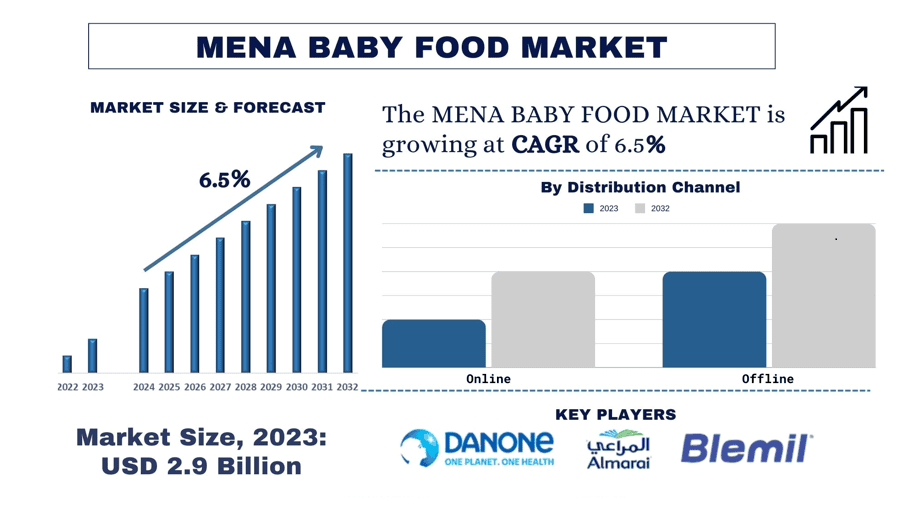
MENA 婴儿食品市场规模与预测
2023 年 MENA 婴儿食品市场估值为 29 亿美元,预计在预测期内(2024-2032 年)将以 6.5% 的复合年增长率增长。
MENA 婴儿食品市场分析
MENA地区对婴儿食品日益增长的需求为国内外企业提供了大量机会。专注于产品创新、分销网络改进以及与当地零售商和医疗保健提供商建立战略合作伙伴关系的扩张战略,可以帮助公司利用该地区尚未开发的潜力。此外,包装技术的进步,如自立袋和可重复密封的容器,提供了更大的便利性和便携性,进一步推动了市场增长。此外,随着互联网普及率和智能手机使用率的提高,数字营销和电子商务平台为公司与消费者互动和推动销售提供了一个有希望的途径。影响 MENA 婴儿食品市场的主要趋势包括有机和天然成分的日益普及、高端产品供应的出现以及社交媒体影响者在塑造消费者偏好和购买决策方面日益增长的影响力。
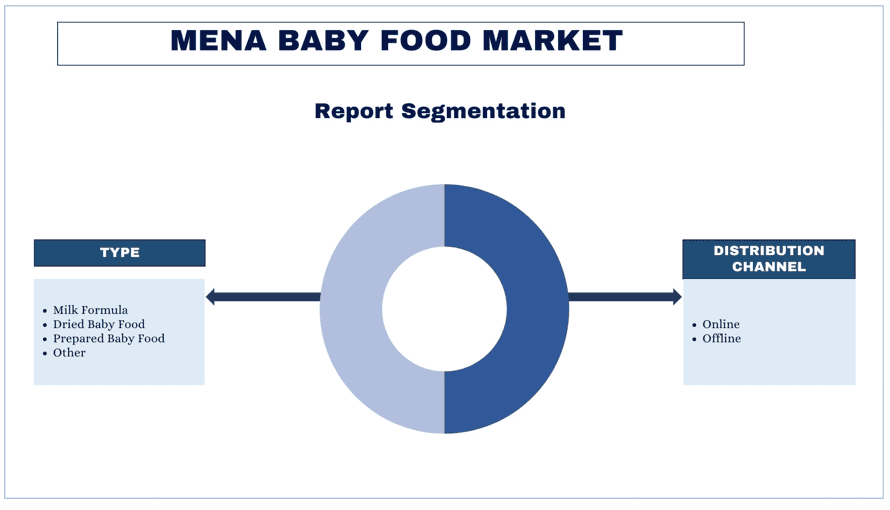
MENA 婴儿食品市场趋势
本节讨论了我们的研究专家团队确定的影响 MENA 婴儿食品市场各个细分市场的关键市场趋势。
干燥婴儿食品行业
由于干燥婴儿食品产品保质期长、方便且价格实惠,因此在 MENA 国家/地区越来越受欢迎。这些产品包括谷物、水果和蔬菜泥以及零食,为寻求营养选择的婴幼儿父母提供了一种便捷的解决方案。此外,干燥婴儿食品的便携性使其非常适合在旅途中食用,满足城市地区普遍存在的忙碌生活方式。此外,核心家庭的日益普及和对即食食品的需求进一步推动了该地区对干燥婴儿食品产品的需求。
- 2022 年 6 月,澳大利亚婴儿营养初创公司 Sprout Organic 与全球最大的电子商务平台亚马逊合作,推出了其植物性婴儿配方奶粉。Sprouts 在沙特食品博览会上在中东推出了其有机婴儿食品。
- 2022 年 3 月,总部位于达喀尔的 Le Lionceau 公司专门为 6 个月至 36 个月的儿童生产和销售产品,该公司在塞内加尔推出了其产品。该公司声称其产品营养丰富,由当地生产的水果、蔬菜、谷物和配料制成。
- 2021 年 9 月,Kylie Jenner 在非洲和全球推出了“Kylie Baby”。该产品可在非洲的 Takealot 网站上购买。
预计阿联酋在预测期内将以显著的复合年增长率增长
近年来,阿联酋的婴儿食品市场 取得了显著增长。这种激增可归因于多种因素,包括父母越来越意识到营养对婴儿的重要性。可支配收入的增加以及对优质产品的偏好也推动了该市场的发展。阿联酋对食品安全法规的承诺及其高质量产品的声誉使其成为婴儿食品制造商的理想目的地。此外,阿联酋不断增长的外籍人口通常重视食品选择,这为该行业的企业带来了重要的增长机会。
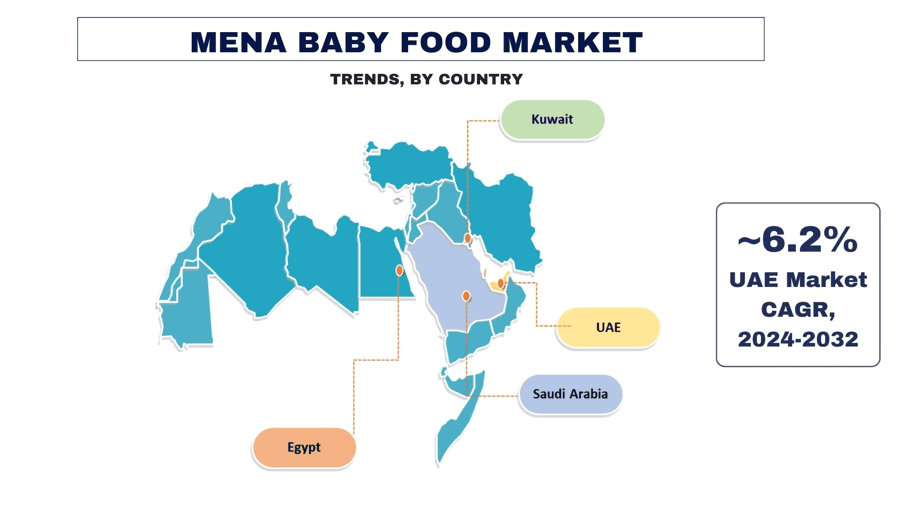
MENA 婴儿食品行业概览
MENA 婴儿食品市场竞争激烈且分散,有几家全球和国际市场参与者。主要参与者正在采取不同的增长战略来增强其市场地位,例如合作伙伴关系、协议、协作、新产品发布、地域扩张以及并购。市场上的一些主要参与者包括雀巢公司、雅培、The Baby Food Company、Saipro Biotech Private Limited、Orchard Food、Bumbles、TIGER BRANDS、达能 S.A.、Almarai、Ordesa。
MENA 婴儿食品市场新闻
- 例如,根据 Tetrapak 的数据,2020 年在中东推出的婴儿奶粉和食品占总量的 27%。
欧睿国际进行的一项调查发现,阿联酋和沙特阿拉伯有 60% 的消费者积极寻找清真认证产品,包括有机产品。
MENA 婴儿食品报告覆盖范围
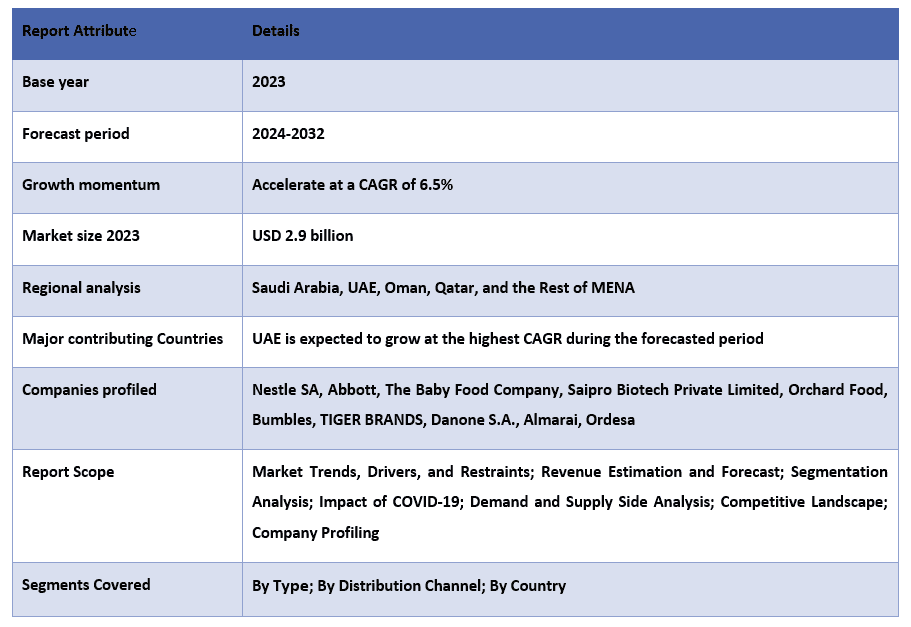
购买本报告的理由:
- 该研究包括经过认证的关键行业专家验证的市场规模和预测分析。
- 该报告一目了然地介绍了整个行业绩效的快速回顾。
- 该报告深入分析了杰出的行业同行,主要关注关键业务财务、产品组合、扩张战略和最新发展。
- 详细考察行业中普遍存在的驱动因素、限制因素、关键趋势和机遇。
- 该研究全面涵盖了跨不同细分市场的市场。
- 深入的行业区域层面分析。
定制选项:
MENA 婴儿食品市场可以根据需求或任何其他细分市场进一步定制。除此之外,UMI 了解您可能有自己的业务需求,因此请随时与我们联系以获取完全符合您要求的报告。
目录
MENA婴儿食品市场分析 (2024-2032) 的研究方法
分析历史市场,估计当前市场,并预测MENA婴儿食品市场的未来市场,是创建和分析主要地区婴儿食品采用情况的三个主要步骤。进行了详尽的二级研究,以收集历史市场数据并估计当前市场规模。其次,为了验证这些见解,考虑了大量的发现和假设。此外,还对MENA婴儿食品市场价值链中的行业专家进行了详尽的初步访谈。通过初步访谈对市场数据进行假设和验证后,我们采用了自上而下/自下而上的方法来预测完整的市场规模。此后,采用市场分解和数据三角测量方法来估计和分析行业相关细分市场和子细分市场的市场规模。详细方法如下所述:
历史市场规模分析
步骤1:深入研究二级来源:
进行了详细的二级研究,以通过公司内部来源(如年度报告和财务报表、业绩演示文稿、新闻稿等)以及外部来源(包括期刊、新闻和文章、政府出版物、竞争对手出版物、行业报告、第三方数据库和其他可信出版物)获得MENA婴儿食品市场的历史市场规模。
步骤2:市场细分:
在获得MENA婴儿食品市场的历史市场规模后,我们进行了详细的二级分析,以收集主要地区不同细分市场和子细分市场的历史市场见解和份额。报告中包含的主要细分市场包括类型、技术、组件和最终用户。此外,还进行了国家/地区层面的分析,以评估该地区测试模型的总体采用情况。
步骤3:因素分析:
在获得不同细分市场和子细分市场的历史市场规模后,我们进行了详细的因素分析,以估计MENA婴儿食品市场的当前市场规模。此外,我们使用MENA婴儿食品市场的类型、技术、组件和最终用户等因变量和自变量进行了因素分析。我们对需求和供应侧情景进行了彻底的分析,其中考虑了全球MENA婴儿食品市场领域中的顶级合作伙伴关系、并购、业务扩张和产品发布。
当前市场规模估算和预测
当前市场规模:根据上述3个步骤的可行见解,我们得出了当前的市场规模、MENA婴儿食品市场的关键参与者以及细分市场的市场份额。所有必需的百分比份额拆分和市场细分均使用上述二级方法确定,并通过初步访谈进行了验证。
估算和预测:对于市场估算和预测,我们为不同的因素分配了权重,包括驱动因素和趋势、制约因素以及利益相关者可获得的机会。在分析这些因素之后,我们应用了相关的预测技术,即自上而下/自下而上的方法,以得出2030年全球主要市场不同细分市场和子细分市场的市场预测。用于估算市场规模的研究方法包括:
- 该行业的市场规模,以收入(美元)和MENA婴儿食品市场在国内主要市场的采用率衡量
- 市场细分和子细分的全部百分比份额、拆分和细分
- MENA婴儿食品市场中关键参与者提供的产品。此外,这些参与者为在快速增长的市场中竞争而采取的增长策略
市场规模和份额验证
初步研究:与关键意见领袖 (KOL) 进行了深入访谈,包括主要地区的高层管理人员(CXO/副总裁、销售主管、营销主管、运营主管、区域主管、国家/地区主管等)。然后对初步研究结果进行总结,并进行统计分析以证明所述假设。初步研究的输入与二级研究结果相结合,从而将信息转化为可行见解。
不同地区的初步参与者细分
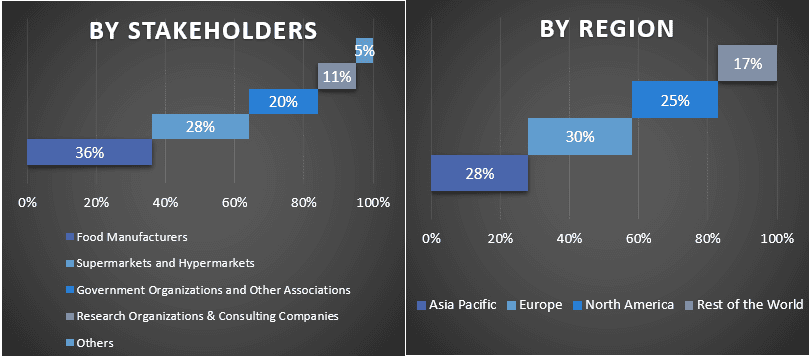
市场工程
采用数据三角测量技术来完成整体市场估算,并得出MENA婴儿食品市场每个细分市场和子细分市场的精确统计数字。在研究MENA婴儿食品市场中类型、技术、组件和最终用户等领域的各种参数和趋势后,数据被分为几个细分市场和子细分市场。
MENA婴儿食品市场研究的主要目标
该研究明确指出了MENA婴儿食品市场的当前和未来市场趋势。投资者可以获得战略见解,以根据研究中进行的定性和定量分析来判断投资。当前和未来市场趋势决定了市场在区域层面的整体吸引力,为行业参与者提供了一个平台,以利用未开发的市场,从而从先发优势中受益。研究的其他定量目标包括:
- 分析MENA婴儿食品市场当前和预测的市场规模(以价值(美元)计)。此外,分析不同细分市场和子细分市场的当前和预测的市场规模。
- 研究中的细分市场包括类型、技术、组件和最终用户等领域。
- 定义和分析MENA婴儿食品的监管框架
- 分析涉及各种中介机构的价值链,并分析行业客户和竞争对手的行为。
- 分析MENA婴儿食品市场主要地区的当前和预测的市场规模。
- 报告中研究的主要区域国家/地区包括亚太地区、欧洲、北美和世界其他地区
- MENA婴儿食品市场的公司概况以及市场参与者为在快速增长的市场中保持生存而采取的增长策略。
- 深入分析行业区域层面
常见问题 常见问题
Q1:MENA婴儿食品市场目前的市场规模和增长潜力是什么?
Q2:MENA婴儿食品市场增长的驱动因素有哪些?
Q3:按类型划分,哪个细分市场在中东和北非婴儿食品市场中占有最大的份额?
第四季度:MENA婴儿食品市场的新兴技术和趋势有哪些?
Q5:哪个地区将主导MENA婴儿食品市场?
相关 报告
购买此商品的客户也购买了










